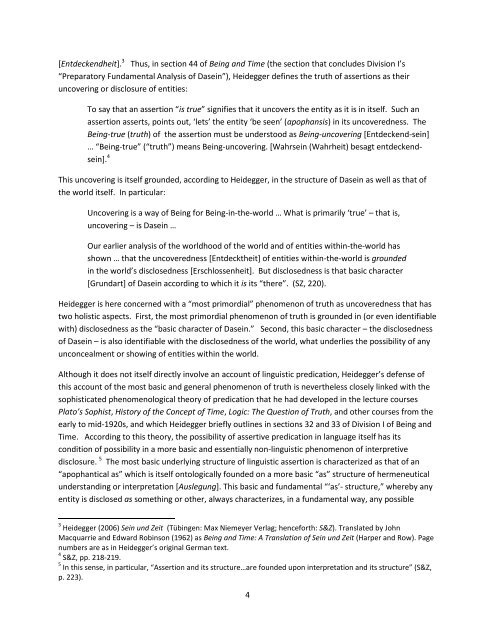Heidegger, Tugendhat, Davidson - University of New Mexico
Heidegger, Tugendhat, Davidson - University of New Mexico
Heidegger, Tugendhat, Davidson - University of New Mexico
Create successful ePaper yourself
Turn your PDF publications into a flip-book with our unique Google optimized e-Paper software.
[Entdeckendheit]. 3 Thus, in section 44 <strong>of</strong> Being and Time (the section that concludes Division I’s<br />
“Preparatory Fundamental Analysis <strong>of</strong> Dasein”), <strong>Heidegger</strong> defines the truth <strong>of</strong> assertions as their<br />
uncovering or disclosure <strong>of</strong> entities:<br />
To say that an assertion “is true” signifies that it uncovers the entity as it is in itself. Such an<br />
assertion asserts, points out, ‘lets’ the entity ‘be seen’ (apophansis) in its uncoveredness. The<br />
Being-true (truth) <strong>of</strong> the assertion must be understood as Being-uncovering [Entdeckend-sein]<br />
… “Being-true” (“truth”) means Being-uncovering. [Wahrsein (Wahrheit) besagt entdeckendsein].<br />
4<br />
This uncovering is itself grounded, according to <strong>Heidegger</strong>, in the structure <strong>of</strong> Dasein as well as that <strong>of</strong><br />
the world itself. In particular:<br />
Uncovering is a way <strong>of</strong> Being for Being-in-the-world … What is primarily ‘true’ – that is,<br />
uncovering – is Dasein …<br />
Our earlier analysis <strong>of</strong> the worldhood <strong>of</strong> the world and <strong>of</strong> entities within-the-world has<br />
shown … that the uncoveredness [Entdecktheit] <strong>of</strong> entities within-the-world is grounded<br />
in the world’s disclosedness [Erschlossenheit]. But disclosedness is that basic character<br />
[Grundart] <strong>of</strong> Dasein according to which it is its “there”. (SZ, 220).<br />
<strong>Heidegger</strong> is here concerned with a “most primordial” phenomenon <strong>of</strong> truth as uncoveredness that has<br />
two holistic aspects. First, the most primordial phenomenon <strong>of</strong> truth is grounded in (or even identifiable<br />
with) disclosedness as the “basic character <strong>of</strong> Dasein.” Second, this basic character – the disclosedness<br />
<strong>of</strong> Dasein – is also identifiable with the disclosedness <strong>of</strong> the world, what underlies the possibility <strong>of</strong> any<br />
unconcealment or showing <strong>of</strong> entities within the world.<br />
Although it does not itself directly involve an account <strong>of</strong> linguistic predication, <strong>Heidegger</strong>’s defense <strong>of</strong><br />
this account <strong>of</strong> the most basic and general phenomenon <strong>of</strong> truth is nevertheless closely linked with the<br />
sophisticated phenomenological theory <strong>of</strong> predication that he had developed in the lecture courses<br />
Plato’s Sophist, History <strong>of</strong> the Concept <strong>of</strong> Time, Logic: The Question <strong>of</strong> Truth, and other courses from the<br />
early to mid-1920s, and which <strong>Heidegger</strong> briefly outlines in sections 32 and 33 <strong>of</strong> Division I <strong>of</strong> Being and<br />
Time. According to this theory, the possibility <strong>of</strong> assertive predication in language itself has its<br />
condition <strong>of</strong> possibility in a more basic and essentially non-linguistic phenomenon <strong>of</strong> interpretive<br />
disclosure. 5 The most basic underlying structure <strong>of</strong> linguistic assertion is characterized as that <strong>of</strong> an<br />
“apophantical as” which is itself ontologically founded on a more basic “as” structure <strong>of</strong> hermeneutical<br />
understanding or interpretation [Auslegung]. This basic and fundamental “‘as’- structure,” whereby any<br />
entity is disclosed as something or other, always characterizes, in a fundamental way, any possible<br />
3 <strong>Heidegger</strong> (2006) Sein und Zeit (Tübingen: Max Niemeyer Verlag; henceforth: S&Z). Translated by John<br />
Macquarrie and Edward Robinson (1962) as Being and Time: A Translation <strong>of</strong> Sein und Zeit (Harper and Row). Page<br />
numbers are as in <strong>Heidegger</strong>’s original German text.<br />
4 S&Z, pp. 218-219.<br />
5 In this sense, in particular, “Assertion and its structure…are founded upon interpretation and its structure” (S&Z,<br />
p. 223).<br />
4
















